












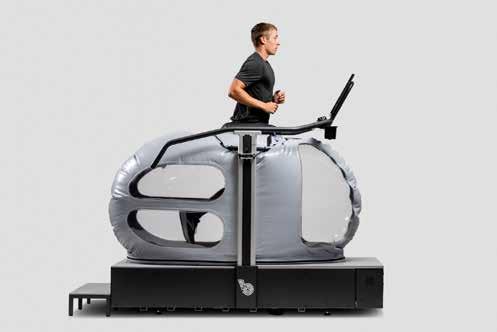


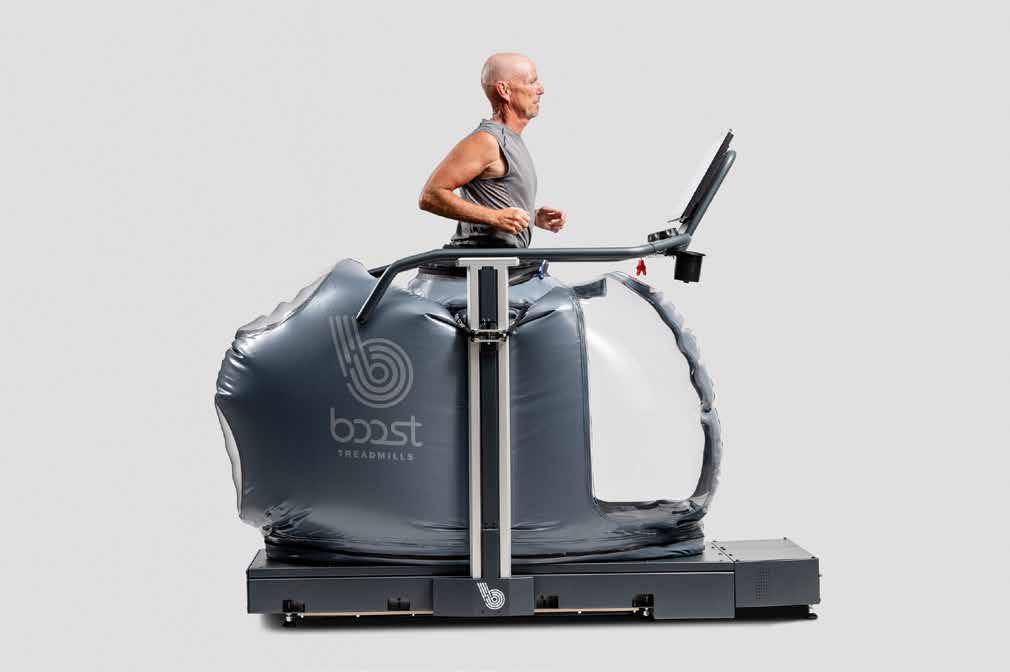


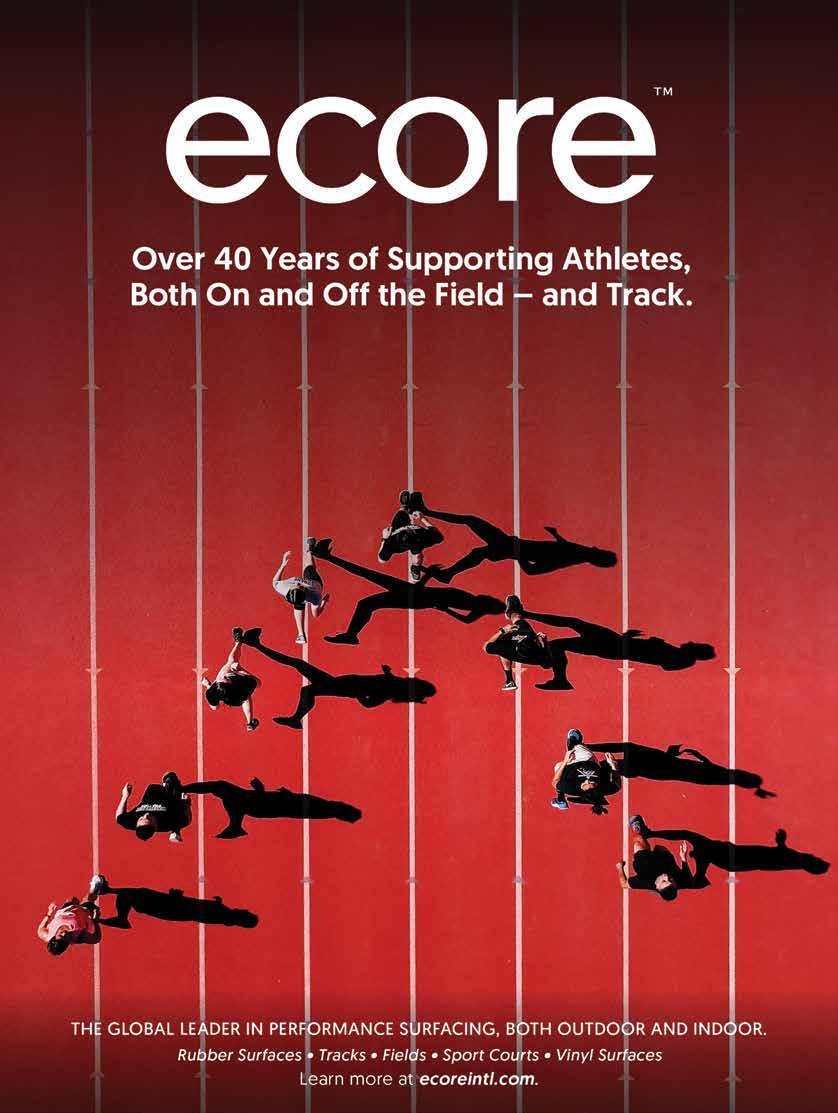




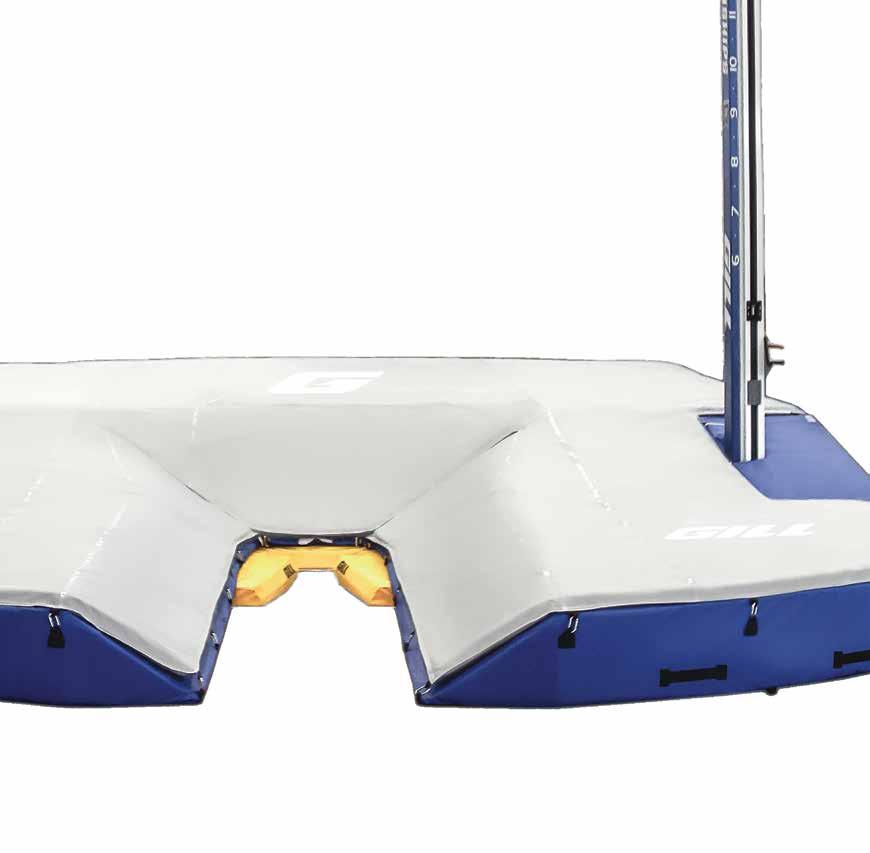







CARYL SMITH GILBERT
USTFCCCA President
Caryl Smith Gilbert is the Director of Men’s and Women’s Track & Field at the University of Georgia. Caryl can be reached at UGATFXC@sports.uga.edu
MARC DAVIS
Track & Field
Marc Davis is the Director of Track &Field and Cross Counry at Troy University. Marc can be reached at mddavis@troy.edu.

TINA DAVIS FERNANDEZ
Track & Field
Tina Davis Fernandez is the Head Cross Country and Track & Field Coach for CAL State LA. Tina can be reached at Tina.DavisFernandes@ calstatela.edu
CHAD GUNNELSON
Track & Field
Chad Gunnelson is the Director of Track and Field and Cross Country at Augustana College. Chad can be reached at chadgunnelson@augustana.edu


CALEB SNYDER
Track & Field
Caleb Snyder is the Head Men’ and Women’s Track & Field Coach at Indiana Wesleyan University. Caleb can be reached at caleb.snyder@indwes.edu

CHIP GAYDEN
Track & Field
Chip Gayden is the Head Men’s and Women’s Track & Field Coach at Meridian Community College. He can be reached at hgayden@meridiancc.edu

STEFANIE SLEKIS
Cross Country
Stefanie Slekis is the Head Coach of Track and Field and Cross Country at Nicholls State University. Stefanie can be reached at stefanie.slekis@nicholls.edu
PUBLISHER
Sam Seemes
MEMBERSHIP SERVICES
Nick Lieggi, Samantha Morse, Kristina Taylor, Dave Svoboda
COMMUNICATIONS
Garrett Bampos, Tom Lewis, Tyler Mayforth, Howard Willman
PHOTOGRAPHER
Kirby Lee
EDITORIAL BOARD
Tommy Badon, Scott Christensen, Todd Lane, Derek Yush
ART DIRECTOR
Tiffani Reding Amedeo
PUBLISHED BY
ERIC PHILLIPS
Cross Country
Eric Phillips is the men’s distance assistant coach for track and field and cross country at Saginaw Valley State University. He can be reached at edphilli@svsu.edu.
RYAN CHAPMAN
Cross Country
Ryan Chapman is the Head Coach of Men’s and Women’s Cross Country at Wartburg College. Ryan can be reached at ryan.chapman@wartburg.edu
Renaissance Publishing LLC
110 Veterans Memorial Blvd., Suite 123, Metairie, LA 70005 (504) 828-1380
myneworleans.com
GRIER GATLIN
Cross Country
Grier Gatlin is the Head Coach of Track and Field and Cross Country at Southern Oregon University. Grier can be reached at gatling@sou.edu
DEE BROWN
Cross Country
Dee Brown is the Director of Track and Field and Cross Country at Iowa Central CC. Dee can be reached at brown_dee@iowacentral.edu
USTFCCCA
National Office 1100 Poydras Street, Suite 1750 New Orleans, LA 70163 Phone: 504-599-8900 Website: ustfccca.org
If you would like to submit content for, or advertise your business in Techniques, please contact 504-599-8906 or techniques@ustfccca.org.
Techniques (ISSN 1939-3849) is published quarterly in February, May, August and November by the U.S. Track & Field and Cross Country Coaches Association. Copyright 2025. All rights reserved. No part of this publication may be reproduced in any manner, in whole or in part, without the permission of the publisher. techniques is not responsible for unsolicited manuscripts, photos and artwork even if accompanied by a self-addressed stamped envelope. The opinions expressed in techniques are those of the authors and do not necessarily reflect the view of the magazines’ managers or owners. Periodical Postage Paid at New Orleans La and Additional Entry Offices. POSTMASTER: Send address changes to: USTFCCCA, PO Box 55969, Metairie, LA 70055-5969.


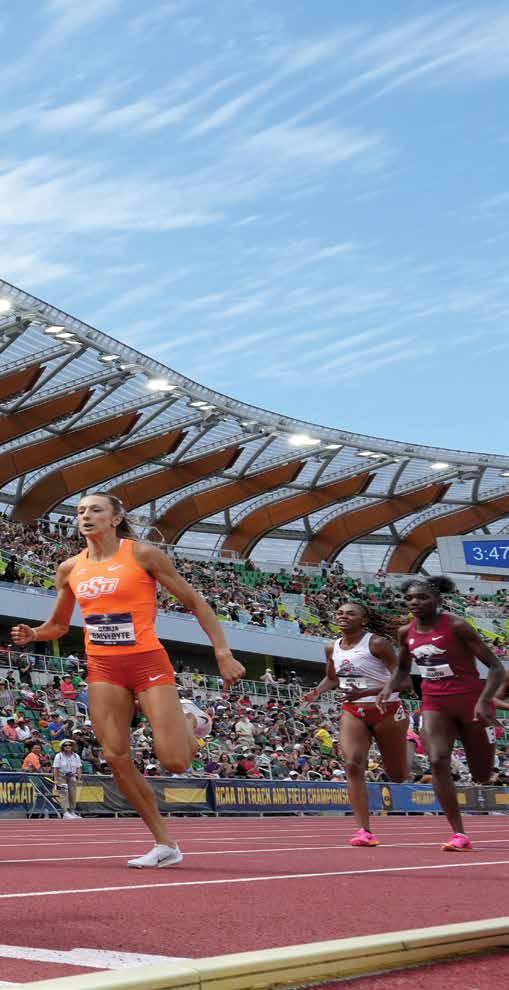
The middle-distance events, ranging from 400 to 1500 meters, may be the most physiologically diverse events to coach. These events require the most mixed training components, from pure speed through to aerobic endurance and everything in between. The 800-meter event can be even more unique. To establish a starting point, consider an athlete’s potential and ability at 400, 800 and 1,500 meters to determine if they can successfully race the 800 meters. Next, what training program or group will the 800-meter runner fit into? You can break today’s 800meter runner into three types: 400/800 runner, 800-meter purist, or an 800/1500 type runner. Each will need to be trained slightly differently, adjusting the physiological components of the training to the athlete’s physiological make-up and needs.
This can even create an additional question for the coach: Do I have a training group for this athlete? Where does an 800-meteronly type of runner fit into my program?
I believe today’s successful 800-meter runners are coming from the speed side of the event. They may have been 400 runners in the past and are looking to be the 400/800 meter runner, or they have made the decision to move to the 800 specifically.
For the runners moving up from 400 meters, understanding the differences in energy system contributions and applying them to the training plan is a big part of the transition. The need for progressive types of training sessions becomes even more important. As shown below, the aerobic portion of the events moves from approximately 38% to 61%, which is a significant increase. While the other two, anaerobic speed components, have a smaller change. This aerobic development is crucial for the aerobic strength needed to maintain a high percentage of their 400-meter speed for a longer time within the 800-meter race. These runners will need the patience to develop this aerobic portion, as it will take time.
Mentally, the runner moving up to 800 meters will need to gain the confidence of being able to run at that high an intensity for double the distance. The progression outlined later allows the runner to gradually develop the confidence and understanding of how to run the race. Continuing the rhythm of the 400 meters past 400 meters, going to 800 meters, will be a new experience for this group.

CHART 1.
AEROBIC (O2)/LACTIC (GLYCOLYTIC)/A-LACTIC (ATP-PC)
400 meters .....................38/50/12
800 meters .....................61/33/6
1500 meters 80/20/0
PERCENTAGE OF VO2MAX
400 meters .....................140-156% of VO2max
800 meters 120-136% of VO2max
1500 meters ...................110-112% of VO2max
3000 meters ...................100-102% of VO2max
2.
14 DAY TRAINING CYCLE
Type of Session ..................................... Pace
Day 1 ............ Speed/Power/Strength (ATP-PC) ......... 100/200
Day 2 ............ VO2max/aerobic ....................................... 1500
Day 3 Recovery/mobility
Day 4 ............ Lactate/Strength training ........................... 800
Day 5 ............ Recovery
Day 6 ............ Aerobic or competition ............................. 5000 Day 7 Recovery
Day 8 ............ Speed Endurance/Strength ........................ 400 Day 9 ............ Aerobic Threshold ..................................... 5000 Day 11 Lactate Tolerance 800
Day 12 .......... Recovery/Mobility
Day 13 .......... Competition or Anaerobic ....................... T.B.D.
Day 14 Recovery/Off
The 400 and 800-meter races have an aerobic and an anaerobic component of energy contribution. You need to consider both energy zones, and really, all three physiological realms of Aerobic (O2), Anaerobic Lactic (Glycolytic), and Anaerobic A-Lactic (ATP-CP) when looking at the demands of the event and developing the annual training plan. This is where trying to determine the athletes’ abilities in these physiological realms will help in developing the training plan that addresses the individual athlete’s physiological strengths and weaknesses. Looking at the changes in energy requirements from the 400 to 800 meters, the coach and athlete can see where the changes in training will be developed to move the runner forward to adapt to the 800-meter race.
See chart 1.
LEAVE NO STONE UNTURNED -
DEVELOPING ALL ASPECTS OF TRAINING
There is no right or wrong way to train 800meter athletes, and no specific training system that works for all; there are too many variables that change the way each athlete should be coached. Science and technology are important tools to use in developing training plans for any event, but understanding the individual and how they respond to training stimuli is equally important. The goal should be to train the individual, as opposed to training the event. Both will use science when designing the training plan and use experience and history to help develop the plan. However, communication, understanding of the athlete’s strengths and weaknesses, and the ability to adjust help to efficiently travel the route to the athlete’s success. Over my career, I have used a multi-pace training system to develop my 800-specific runners. With a multi-pace system, one does not train at the same pace or type of training every hard day, but trains at different paces throughout each training phase. There are
five different phases within each cycle, beginning with a recovery phase and progressing toward peak performance. During each one of the phases of a training cycle, a specific type of pace is emphasized to establish the desired physiological response emphasized in that phase, while not neglecting the other components of training. These training days are referred to as primary workouts. Other training sessions during that phase are secondary or maintenance sessions.
See chart 2.
I not only looked at putting training cycles together, but also looked at specific energy zone training progressions within the training cycles, and developed specific training session progressions from early season to peak performance. Still keeping in mind training cycles and recovery weeks between cycles.
The 800-meter specific and 800-meter lactate tolerance progressive training sessions below are the backbone of the event-specific


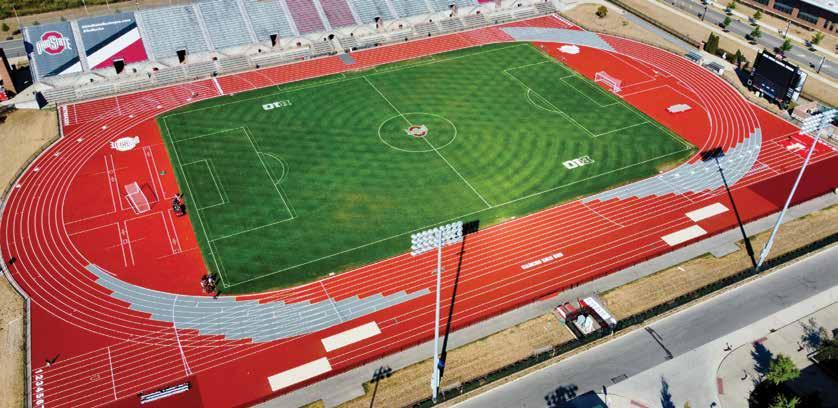
Beynon controls all aspects of the manufacturing value chain. From start to finish, your project doesn’t leave our hands.
Manufactured and installed with the highest attention to detail, Beynon systems showcase proven durability.
For indoor or outdoor venues, Beynon is the trusted surface of leading NCAA Div I programs, thousands of high schools and distinguished municipal facilities.
Part of Tarkett Sports, a division of the Tarkett Group, a worldwide leader of innovative flooring and sports surface solutions, Beynon has unprecedented financial support and stability. You can rest easy.
CHART 3.
200/400 METER TRAINING PROGRESSIONS
10 x 100 @ 400 goal pace (3 min. recovery)
8 x 150 @ 400 goal pace (5 min. recovery)
6 x 200 @ 400 goal pace (6 min. recovery)
4 x 250 @ 400 goal pace (8 min. recovery)
3 x 300 @ 400 goal pace (10 min. recovery)
2 x 350 @ 400 goal pace (full recovery)
VO2MAX PROGRESSIONS FOR 800/1500
2-3 x 5 x 400
800 METER LACTATE TOLERANCE PROGRESSIONS
4 x 200 @ goal pace (35 sec. recovery)
5 x 200 @ goal pace
2 x 4 x 200 @ goal pace
4 x 300 @ goal pace (45 sec. recovery)
2 x 4 x 300 @ goal pace
SPEED SESSION PROGRESSIONS (A-LACTIC (ATP-PC)
2 x 3 x 30 meters
10-12 x 400 6 x 30 meters
3
6-8 x
2 x 4 x 800 2 x 3 x 60 meters
6-8 x 800 4-5 x 40-meter flys
2 x 2 x 1000 4-5 x 60-meter flys
4-5 x 1000
2-3 x 1200
(Jog recovery between reps with a 1:1 ratio and a 2:1 ratio between sets)
800 METER SPECIFIC PROGRESSIONS
Session #1
200 @ goal pace
400 @ float pace
@ goal pace
Session #2
Session #3
@ goal pace
@ float pace
@ goal pace
Session #4
Session #5 Session #7
@ goal pace
@ float pace
@ goal pace
Session #6
@ goal pace
@ float pace
@ goal pace
Session #8
300 @ goal pace 400 @ goal pace 500 @ goal pace 100 @ goal pace
300 @ float pace 200 @ float pace 100 @ float pace 100 @ float pace
200 @ goal pace 200 @ goal pace
@ goal pace 600 @ goal pace
training in our program. With these progressions, we typically start about 16 weeks out from the end of the season, the beginning of indoor track and field season, and following their early-season aerobic base period. They are spaced throughout the season, so the final training sessions are at the end of the season, just before, or at the start of a taper period. These progressions are followed in order without skipping any.
See chart 3.
The paces for the event-specific and lactate tolerance progressions are run at the seasonend goal pace, allowing runners to work on and adapt to the desired paces/rhythms right from the start. Early in the season, these sessions are manageable and not as intense. As the distance at goal pace lengthens and the recovery portion shortens, the intensity of these sessions increases. This coincides with lower intensity, higher volumes sessions in
early season and higher intensities and lower volumes later in season. This system progresses up-tempo portions of training using the short-to-long method. These progressions also help the athlete develop their mental skills. Each session builds off the prior session, with successful completion of session after session, they provide an opportunity for the athlete to build confidence in the ability to maintain the goal paces/rhythms. They close the gap between what athletes can do in practice and the ability to execute in the race. The 800-specific progressions also allow the athlete to develop their race plan and how to execute different phases of the race within the training sessions. Typically, for the 800-meter race, we can break down the race into several general phases with the goal of executing each phase with a specific goal and pace. Each athlete must determine where the different zones of their race are and at what pace or rhythm works best for them.
Below are typical zones of the 800-meter race with some general objectives for each. The distance of each zone will vary depending on the strengths and race plan for each athlete. This is where developing race plans between the athlete and coach can be determined and executed in the 800-meter specific progressions.
See chart 4.
The other 800-meter training progression used is the lactate tolerance progression. Again, these begin at season-end goal pace with very short recoveries. As with the 800meter specific progressions, the early-season training sessions may be manageable, but as the season progresses, they will be very challenging and can be hard to complete all reps at the desired pace. These sessions will not only help the body to adapt to the pace, but also help the athlete focus on how to run the pace and respond as the fatigue begins to set
Rekortan tracks are known for their balance of force reduction and energy return which delivers speed and athlete welfare.


Over 50 years of experience, Rekortan continues to lead:
Most Olympic Records
Most Diamond League venues
Most certified tracks in the world
Made of 84% renewable & recycled materials
USDA certified products
FEEL THE REKORTAN DIFFERENCE — Schedule a Track Assessment Today.
14-DAY
Sunday Off or Light Aerobic session
Monday Anaerobic A Lactic (ATP-PC
Tuesday

Sunday Off or Light Aerobic Session
Monday
A Lactic (ATP-PC
x 30m (5-6 min. recovery) Cool-Down Weights, Olympic Lifts
Tuesday
Saturday
Sunday
minute run
x 100m Progressive Strides Hurdle Mobility/Stretching Thursday
(35-40

Sunday Off or Light Aerobic Session
Monday Anaerobic A Lactic (ATP-PC
Tuesday
Wednesday
Thursday
Friday Aerobic/Recovery
Saturday Aerobic/
Sunday Off or Light Aerobic Session
Monday
2 x 3 x60m (6-7 min. recovery) Cool-Down Weights, Olympic Lifts
4-5 x 1000m (3-4 min. jog recovery) 3 x 150m Build-Ups Cool-Down
30-40 minute easy recovery run
x 100 m Progressive Strides Hurdle Mobility/Stretching
1-2 x 600-100-100m (full recovery)
3 x 200m Cut-Downs Cool-down Weights
30-40 minute easy run 10 x progressive Strides
3 x 300m (10-12 minute recovery) 4 x 100m Progressive Strides Cool-Down Weights-Olympic Lifts Tuesday
3-4 x 1200m (60 sec. recovery) 3 x 150 Build-Ups Cool-Down/Stretch
Wednesday Aerobic/Recovery
Thursday Anaerobic Lactic
Friday
30-40 minute run 10 x 100m Progressive Strides Hurdle Mobility/Stretching
2 x 3 x 300m (45-50 Second Recovery)
3 x 200 Cut-Downs Cool-Down Weights
Light Run/Warm-Up 4-5 x 100m Progressive Strides Mobility/Stretch
Saturday Competition Competition
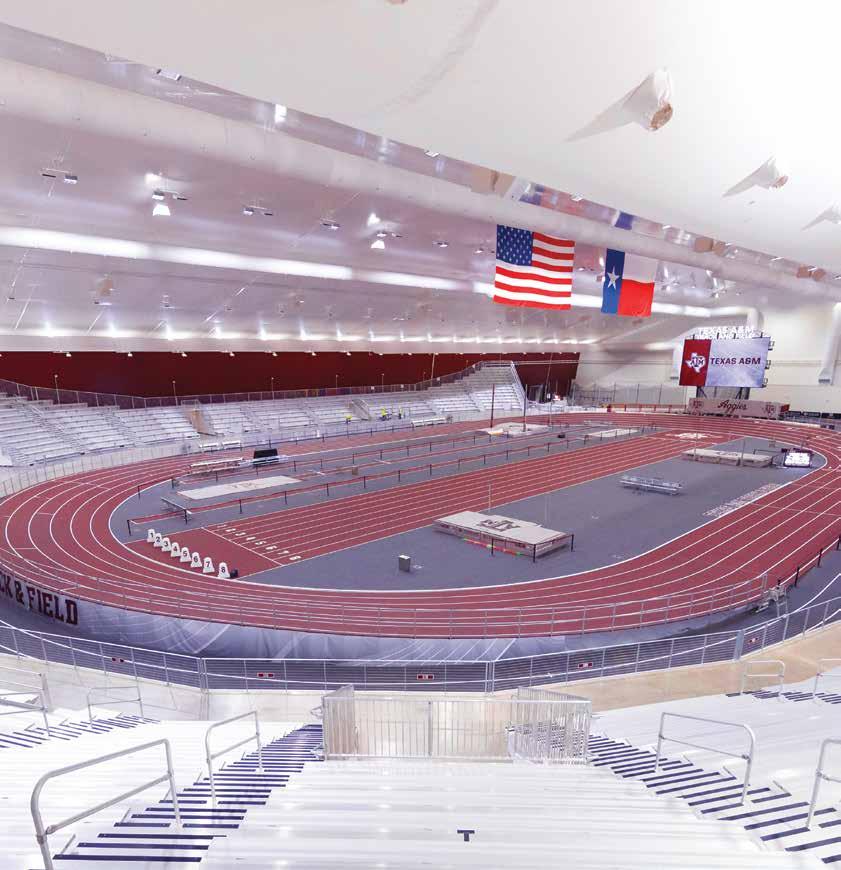
With decades of experience working with top-ranked programs across the country, TenCate brings the latest in surfacing, design and construction technology to the track market.
Fasken Indoor Track & Field
Texas A&M University, College Station, TX
tencategrass.us
Building healthier, more beautiful communities.


in. There are several other 800-meter-specific training sessions that are worked into the 14-day cycle. They are not progressions, but race-specific training sessions also designed to stress the lactate energy system and specifically prepare the athlete to master the different parts of the 800-meter race.
The VO2max (aerobic) progressions are the tough interval training sessions. These sessions are typically a little tougher for our 800 runners, as they often do not like the longer distances, and it may take longer to adapt to running at that intensity for longer durations. By starting the training sessions in
multiple sets of each distance and then progressing to one set of each distance, the athlete is again gaining confidence in their ability to complete a tough session of intervals. These sessions are often done with the 1500meter/middle distance runners. By combining groups on these days, the 800 runners may have a larger group with similar abilities over the interval distance to help through the training session.
The speed training progressions are inserted into the training cycles once every 14 to 21 days. With today’s 800-meter runners and 400 runners moving up to 800 meters,
these runners will have a great need for speed work and neuro-muscular development, and the ATP-PC system. These are max speed sessions that will allow the runner to gradually adapt to the maximum effort over longer distances and an ability to handle greater volumes over the course of the season.
See chart 5.
Many of the 800 runners will participate in cross country during the fall and compete in several of the 8,000-meter cross country races for men and the 6,000-meter races for women. The 8,000 meters to 10,000 meters is often out of their range, and they often do not run the late-season 10,000-meter races, but the strength gained throughout the fall can be invaluable. The women can be more competitive in cross country as the distance only moves up 5,000 to 6,000 meters. The volumes and intensities will be modified to fit their ability and current levels.
In summary, the 800-meter race is a true blend of speed and endurance and needs a training plan that can reflect all the variables that need to be implemented to help the athlete be successful and reach their potential. Setting up and executing a training plan that progresses the athlete towards their goals, physically and mentally, does not always guarantee success, but it will set them up with the best opportunity to progress to their potential in the event. Here is one approach to developing a training plan that allows the athlete to develop and adapt to the demands of the event by building one session upon the next session, and not only adapting to the physiological demands of the event but also the mental demands.
Bowerman, B. (1974). Coaching Track and Field. Houghton Mifflin
Daniels, J. (2022). Daniels Running Formula (4th ed.). Champaign, IL: Human Kinetics
Martin, D.E., & Coe, P.N. (1997). Better Training for Distance Runners (2nd ed.). Champaign, IL: Human Kinetics
Newell, D. Techniques. (2020)
JEFF KAVALUNAS IS CURRENTLY THE HEAD CROSS COUNTRY AND ASSISTANT TRACK AND FIELD COACH AT LINCOLN MEMORIAL UNIVERSITY AND IN HIS 34TH YEAR OF COLLEGIATE HEAD COACHING. IN THAT TIME, HIS 800 METER RUNNERS HAVE CONSISTENTLY COMPETED FOR CONFERENCE AND NATIONAL HONORS.







A practical examination of hamstring injuries by Coach Thorson and a host of other coaches he tasked with exploring an overly complex issue

Hamstring injuries are one of the most problematic issues in track and field. This is especially true with explosive athletes like sprinters, hurdlers and jumpers, but even endurance athletes aren’t immune to hamstring difficulty. It is quite a common injury in the sport because of the demands placed on the hamstring during rapid acceleration and deceleration. The hamstring is very vulnerable anatomically, too, receiving stress from both above and below, and that compounds the issues. The hamstring conundrum has been an on-going point of contention for track and field coaches, strength and conditioning coaches, and athletic trainers for many, many years. And, while there has been progress, a real, sure-fire solution doesn’t seem to be on the horizon.
The primary objective of this article is to assist the coach in understanding the causes, and practical prevention and rehabilitation of hamstring injuries. A secondary focus is understanding the function of the hamstring in sprinting and how the coach can work with athletic trainers and strength and conditioning coaches to deal with hamstring problems once they occur.
We reached out to all three groups — coaches, athletic trainers, and strength and conditioning coaches — to survey their thoughts on topics related to hamstring injuries. There were certainly a lot of commonalities. However, we also found some interesting differences in perspective that we will share.
Before a coach can really understand hamstring injuries, they must understand the hamstring and its workings in the sprint process. Keeping that in mind, this presentation will explore the following topics in order: (1.) the makeup, role and function of the hamstring as a primary mover in synergistic sprinting movements; (2.) the primary causes of hamstring issues; (3.) what can be done to prevent hamstring injuries and their reoccurrence; (4.) methods and information involved in the rehabilitation of hamstring injuries once they occur; (5.) the protocol for athletes with chronic hamstring injuries.
Hamstring
Sprinting is a very high intensity activity that requires the coordinated and harmonious action of multiple muscle groups working together to produce the power and rapid movements that translate to speed. The hamstring, located at the back of the thigh and comprised of the biceps femoris, semitendinosus and the semimembranosus, is considered one of the primary movers in sprinting. The biceps femoris has two heads: the long head, which originates from the

ischial tuberosity, and the short head, which originates from the femur. The semitendinosus and semimembranosus also originate from the ischial tuberosity. All three of the muscles insert on the tibia or the fibula, allowing them to flex the knee and extend the hip. The other muscle groups which are considered primary movers are the quadriceps, the gluteus maximus, the calf muscles and the hip flexors, but it is the hamstrings that play a critical role in hip extension and knee flexion. To simplify, the hamstrings are responsible for hip extension, knee flexion and the controlled deceleration and acceleration of the leg. The following is breakdown of the hamstring’s role in all four phases of the sprint:
*Start When the sprinter pushes off from the blocks with explosive power, the hamstring contributes to this initial force by extending the hip, allowing the athlete to drive forward. A very strong contraction of the hamstrings propels the athlete from the blocks.
*Acceleration Phase The hamstrings continue to play a vital role as the athlete transitions from the start to full speed. The ham-
strings work in concert with the quadriceps to extend the hip and flex the knee, bringing about rapid leg movement. It is during this phase that the hamstrings help to control the leg’s recovery, pulling it back under the body quickly and efficiently.
*Maximum Velocity Phase The hamstrings are highly active when the athlete is at top speed. They function eccentrically to decelerate the forward swing of the leg, preparing it for ground contact. This eccentric contraction is crucial for absorbing the impact forces and reducing the chances of injury. At this point, the hamstrings contract concentrically to extend the hip and initiate the next stride, maintaining speed as the sprinter propels their body down the track.
*Deceleration and Finish As the athlete begins to decelerate, the hamstrings remain engaged to maintain balance and stability. They help to control the slowing down process, allowing the sprinter to finish with the proper form and without strain.
To conclude, it is easy to see why the hamstrings are indispensable in the sprinting process, providing the speed, powe, and control necessary for sprint success.
Hamstring injuries can be caused by many different factors. Often it is difficult to pinpoint the real cause, because typically it is a combination of factors that contribute to the injury. Most coaches will agree, too, that the hamstring is very seldom the root cause. Hamstring injuries typically result from dysfunction elsewhere in the body.
Some of the major causes of hamstring injuries have been listed below. Some we have witnessed, and some have been contributed by our survey of track and field mentors, strength and conditioning coaches, and athletic trainers who work with track and field programs.
The major causes of hamstring injuries with explanations and details where needed: Anterior pelvic tilt (APT) This is a condition where the front of the spine drops and the back of the pelvis rises, altering the alignment of the hips and spine. Many coaches feel this is a leading cause of hamstring problems. Efficient hip extension is critically important for optimal sprinting performance. APT disrupts the natural biomechanics by limiting the effective range

of motion in the glutes and increasing the workload of the hamstrings, ultimately leading to what is called “synergistic dominance” and the likelihood of injury to the hamstring. “Anterior pelvic tilt has to be the number one cause of hamstring injuries,” commented Cale Korbelik, the very accomplished track and field coach at the University of Mary in Bismarck, North Dakota. “Neutral pelvic alignment is a key to good sprinting.”
Synergistic dominance First of all, what is synergistic dominance? Synergistic dominance in sprinting is a biomechanical occurrence where secondary muscles compensate for the weakness or inhibition of primary muscles during movement. This action can lead to imbalances and undue stress on the muscles, increasing the risk of injury. Synergistic dominance plays a critical role in hamstring injuries. Typically, the glutes and the lower back muscles try to overcompensate for the weak hamstrings. This leads to an imbalanced distribution of force and increased strain on the hamstrings, ultimately leading to injury. Loren Seagrave of Speed Dynamics, a very well-known elite coach, explains it like this: “Weak hip flexors go into splinting mode for protection from strong glute max (gluteus maximus muscle, the largest and strongest muscle in the buttocks and the heaviest muscle in the body), and the hip extensors then neurologically shut down glutes, and the hamstrings are recruited to produce a greater percentage of force. The result is a hamstring strain or worse,” explained the coach. Splinting mode refers to a protective mechanism in the body where the muscles around an injured area contract tightly to limit movement and further injury.
Incorrect firing patterns/coordination A majority of hamstring issues occur during the foot-ground interaction (terminal swing and braking phase), according to Stu McMillian, the CEO of Altis. The role of the hamstrings in the terminal swing and braking means the muscles, joints, and neural pathways must all work in sync and coordinate correctly while under extreme forces. “Inefficient motor patterns at the neuromuscular level along with suboptimal running mechanics and dehydration are the major factors that contribute to hamstring injuries,” noted Krya Jefferson, the sprint/hurdle coach from Sacramento State.
Improper sprint mechanics/running technique There are a number of sprint mechanic flaws and errors that can contribute to hammy problems. Two in particular:
1. Excessive front side distance; 2. Premature flexion. James Radcliffe, the head strength and conditioning coach for the University of Oregon Ducks, addressed the first issue when he said, “The foot negotiating the ground ahead of the knee and hip is a big factor in hamstring injuries. Athletes are pulling or pawing, versus negotiating down from above,” he said. Seagrave explained the premature plantar flexion. “Premature plantar flexion engages the quadriceps, which produces positive foot speed through knee extension, rather than maintaining a dorsiflexed ankle position which engages the glutes, promoting hip extension and greater negative foot speed,” revealed the Atlanta -based coach who is currently coaching in China. “Hence, greater breaking forces,” he added. “Further, plantar flexion increases frontside distance at touchdown, which results in an increased length of the hamstrings, and a weaker muscle, by passive insufficiency and poor length tension relationship,” noted the long-time coach.
Posture problems/lack of proper body position “Reigning in wild technique and putting the body in the correct planes will greatly decrease exposure to situations where you may see hamstring injuries occur,” said Chris Parno, the highly successful sprint/hurdle coach from Mankato State (Minnesota).
Incorrect warm up or cooldown There is no substitute for an excellent, dynamic warmup to prepare the body for the demands that will be placed on it. An improper warmup can readily lead to hamstring injuries.
Lack of sleep/inadequate recovery
Athletes who have not recovered sufficiently and have not received adequate sleep are very susceptible to hamstring worries.
Poor diet/improper hydration No one will disagree that these are essential. Poor hydration can lead to muscle cramps and a number of muscle issues. Nutrition can affect both muscle strength and endurance.
Lack of mobility/flexibility in the hips, quads, hip flexors, and lumbar region Many of the things that coaches and strength and conditioning personnel do diminishes mobility and flexibility in athletes. This is a component that must be constantly at the forefront of training programs.
Diminished range of motion in the ankle, which limits dorsi-flexion capabilities
This lack of range of motion and limited dorsi-flexion qualities places undesirable stresses on the hamstring, according to Boo
Schexnayder, a remarkably successful former coach at Louisiana State University and noted authority on training design.
Strength imbalances A primary cause of hamstring problems, according to a lot of authorities. Sprinters quite frequently develop very strong quadriceps. When the quadriceps are disproportionately stronger than the hamstrings, the hamstrings must work harder to decelerate, and this increases the risk of injury.
Lack of hip flexor strength/general strength Many of the coaches noted that many programs lack hip flexor strengthening exercises and eccentric hamstring exercises.
Improper training progression/preparation “One of the biggest factors I have seen and experienced in hamstring injuries is not developing a ‘base’ of work that is conducive to holding up under high intensity training, as well as a lack of understanding when it comes to the role of the hamstring in sprinting,” said Calvin Robinson, a very successful sprint/hurdle coach from Texas Tech. “Another factor is poor management of volume, density, and intensity in programming,” the coach added.
Fatigue/ overuse/ overtraining As muscles fatigue, their ability to function properly diminishes and coordination between muscles can decline. Colton Razo, an assistant strength and conditioning coach at Ohio State who works with the track and field program, had an interesting take on hamstring injury factors: “Poor physical preparation and a lack of understanding of the accumulated effects of the global stressors placed upon the athletes,” said the Buckeye coach. “The hamstrings, in both cross-sectional areas, insertion points, and ability to handle force, are the most vulnerable link in highspeed human sprint mechanics. They are your gauge for the overall state of the fatigue of the individual and are therefore a stress gauge,” added the coach. Alexandra Fruetel, the athletic trainer for the University of Minnesota track and field program, added this: “I have noticed a trend with how the muscle recovers with some of my recurring cases. I have noticed that a build-up of fatigue ultimately leads to injury. I would say if they did two hard days of work in a row, I know that by Friday’s workout they most likely will not be able to complete the workout or injury may appear,” explained the trainer.
Previous injuries Athletes with a history of hamstring injuries are at a higher risk for reinjury. Scar tissue from previous injuries
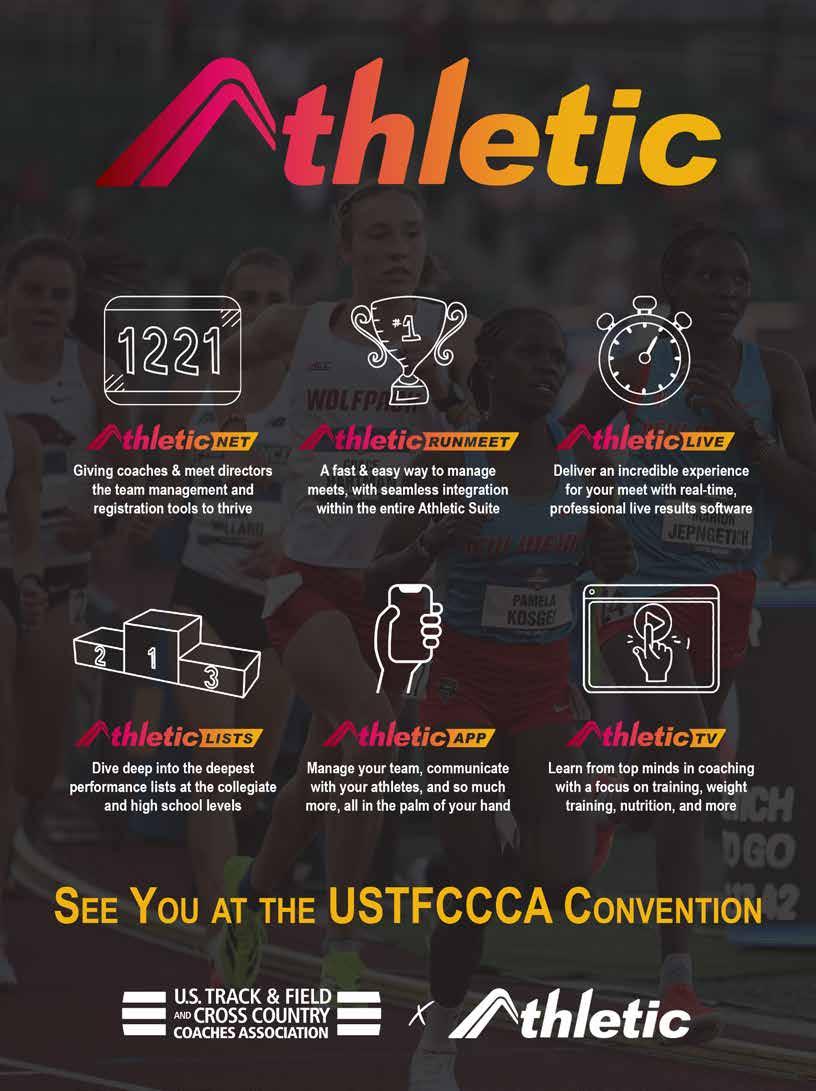
can reduce strength and flexibility and is a common factor. “Too much, too soon and progressing to quickly in general and/or after an injury,” noted Eric Hanenberger, the associate head coach at South Dakota State University, when asked for factors contributing to hamstring issues.
Environmental factors Hard surfaces and cold weather can both lead to muscle fatigue and stiffness and elevate the risk of injury.
There were many different and interesting prevention perspectives that arose from the survey. Although there were a lot of commonalities, there were many different ideas on how to mitigate hamstring injuries. The major prevention concepts from proven practitioners that responded to our survey are listed below:
Balance training load and recovery (proper programming and gradual progression) This was one that nearly all the survey respondents clicked off as being critically important. “Poor programming can lead to injury as quickly as poor mechanics and technique,” voiced Coach Robinson, the Texas Tech associate head coach who has mentored 110 All Americans. “Coaches need to know when to adjust and modify reps and workouts,” expressed LaRon Bennett from Virginia, expounding on correct programming. Coach Hanenberger commented that there must be “flexibility in a training philosophy” and an “individualized” approach.
Strengthening your hamstrings A big focus should be on strengthening the hamstrings, glutes and core muscles to ensure balanced muscle development and a clear road to crucial injury prevention. It should be noted, however, that it is important to balance hamstring and quadricep strength to prevent muscular imbalances that normally result in jury. “The primary exercise intervention that decreased the number of hamstring strain injuries I saw was doing Nordic curls twice a week throughout the entire fall training,” said Jamal Jones, the coordinator of sports performance for cross country and track and field at University of Houston. Coach Robinson, a seven-time Mountain Region Assistant Coach of the Year, says there must be a balance between the track and the weight room. “A balance is needed to ensure the quad- to- hamstring strength ratios are adequately addressed in both in the track training as well in the weight room,” said the coach.
Address strengthening the hamstring
muscles with eccentric exercises Both Seagrave and Korbelik were big proponents of eccentric strength for the hams. “There is typically a lack of eccentric hamstring exercises,” noted Seagrave when asked about causes of hamstring issues.
Improve flexibility and mobility Stretching and flexibility exercises should be done to improve the athlete’s range of motion and to prevent muscle tightness.
Proper warm up and cool down This should be an elementary protocol at any level.
Correct sprint mechanics/ running form/ posture This will promote optimal muscle activation that enhances neuromuscular coordination and ensures the proper activation of the primary muscles. Coach Seagrave had this reply to the importance of proper body position: “Tummy tight, back flat and butt tucked under with pelvis looking up. This neutral pelvis position tending toward a retroverted pelvis shifts the ischial tuberosities forward and gives the optimal length tension relationship in the hamstrings,” said the sprint/hurdle authority. Coach Radcliffe, a very prominent national authority on sport performance, had a very succinct answer when talking about prevention in this area: “A systematic approach to technical proficiency! From warm-up to weight room, to on the track training that progresses in hip dominated mechanics (tilt, hinge, whip) or piston actions, versus knee dominated (heel kick, casting, swinging) or pendulum actions,” declared the coach. Coach Jefferson agreed with Coach Radcliffe. “Enforcing proper technique before incorporating higher intensity workouts has been key,” said the coach, a four-time NCAA national champion while competing for the Florida Gators.
Adequate and sufficient recovery It is essential that explosive athletes prioritize rest and recovery techniques.
Address the anterior pelvic tilt with a combination of stretching, strengthening and postural awareness Anything that the coach and athlete can do to prevent the incorrect pelvic tilt is advantageous, according to many of the survey coaches.
Understand that prehab is much better than rehabilitation Korbelik says it is pretty simple: “Athletes who do the prehab stay ahead of hamstring problems.”
Good communication between all parties to ensure that training on the track and in the weight room is working hand in hand ”There must be communication between
the coach, trainers, and strength staff,” remarked Hanenberger, who joined the staff at South Dakota State in 2015.
There have been a lot of changes in rehabilitation of hamstring injuries since I was an athlete and beginning my coaching career in the 70’s. I started my coaching career in 1979, and at that time, hamstring injuries were basically “a kiss of death.” Rest and stretching were the typical rehab and often, the athlete was done for the year. Sometimes it was career ending, or the athlete battled consistently recurring problems with the hamstring. This is hardly the case today. There were three reoccurring themes that stood out from our review of literature and from our survey of coaches and athletic trainers. First, the cause of the hamstring injury must be determined, or the rehabilitation will be very slow and quite likely the injury will recur. Second, it is very important for the athlete to return to mobility and movement very quickly if an effective, safe, and timely return to the track is to happen. Third, coaches need to understand that every athlete heals differently. Each injury must be treated individually as far as load management and how quickly the athlete can carry out mobility tasks pain- free. Coaches and athletes alike all want to get back on the track as quickly as possible, but they need to know there is no definite timeline for coaches or athletes to follow and implement. This obviously makes the injury more difficult to deal with.
Coach Schexnayder, in his “A Guide to Handling Hamstring Injuries for the Coach,” which can be found on his web site sacspeed.com, says hamstring injuries are very troubling and one of the most misunderstood injuries in track and field. He says this often results in misapplied rehabilitation procedures. “If you don’t fix the cause,” said the coach, “the rehabilitation will progress slowly at best.” Coach Schexnayder offers these “Common Sense Rehabilitation Guidelines” in his guide:
Functional pain- free movement The theme of rehabilitation, according to Schexnayder, should be functional locomotive exercises that are pain- free. He notes that this gentle exercise also limits scar tissue formation, which he says is obviously particularly important.
No stretching at the injury site Static stretching only delays rehabilitation according to the coach. He says that the resump-
tion of static stretching at the injury site should not occur until the range of motion is improved.
DAY ONE W/IN 24 HOURS
1 Hip Hinging
Good Mornings (secondary = stiff-leg deadlift) 3 x 8-12
2 Hip & Knee Hinging
Overhead Squats 3 x 8-12
DAY TWO - 48 HOURS
1 Hip Hinging
Good Mornings (secondary = Russian Deadlift) 3 x 8-12
2 Hip & Knee Hinging
Overhead Squats 3 x 8-12
3 Lateral Hip & Knee Hinge & Sway
DAY THREE - 72 HOURS
1 Top o' the Head Drills
Knee Grab
Froggie
March
2 Acceleration "A" Piston Strengthening
"A" March 2 x 10meters
"A" March backward 1 x 10 m
"A" March w/hip resistance 1 x 10 m
"A" Skip 1 x 15 m
"A" Skip backward 1 x 15 m
"A" Skip w/hip resistance 1 x 15 m
Veloctiy "B" Tilt-Lift-Whip Strengthening
Ankling w/sychronized Hip Tilt 2 x 15 m
"B" Skip 2 x 15 m
Rhythm & Cadence 2 x 20m (straight leg stride w/ "B" whip every 3rd step)
Continuous Fast Leg 2 x 20m
DAY FOUR +
Resisted Running Partner towing, moderate load sleds, ExerGenie Trainer, etc.
VARIATIONS IN THE TRAINING 1-2 X PER WEEK THROUGHOUT
Hip Hinging
Alternating Hanging Knee Pistons
Good Mornings 2 x 3-5 to eventual Single Stance Good Morning & Piston Progressions
Hip & Knee Hinging
Overhead Squats 2 x 3-5
Overhead Press & Lunge 2 4-6
Single Leg Deadlift & Clock Lunge 2 x 8-12
Single Leg Overhead Squat 2 x 2-4 ea.lg.
Step-Up Progressions (Slow >Push-off > Knee Drive > Explosive) 2 x 2-4 ea.lg
Sng. Stance Push and Swing Progressions (Reflexive Strength Work)
Stretch surrounding areas Stretching of the surrounding muscles and muscle groups to prevent chronic tension on the injured muscle is encouraged.
Functional, locomotive rehab The coach was very emphatic that as soon as the patient can move pain-free, rehabilitation must be functional, and movements progressed to running and sprinting.
Schexnayder also offers a very basic six-step hamstring rehabilitation plan:
Walking
Wasy jogging
Jogging
Running
Straight leg bounds
Sprinting
Reece Vega, a successful sprint/ hurdle coach from North Dakota State University, concurs with Coach Schexnayder on the hamstring cause angle. “Every hamstring is different,” said the coach. “The coach needs to identify the reason for the injury and then move forward from there.”
So does Coach Radcliffe, who has authored of number of books on training. “Getting on it within 24 hours of the incident is critical.” noted the coach, who joined the University of Oregon in 1986, and who is a highly regarded authority in the development of strength, speed, and agility. “Time off is the enemy. Getting blood flow back to the area, getting back being hip dominant and negating the build-up of scar tissue is key,” said the coach. “Twenty-plus years of keeping track of these effects, and the timeline to how quick the recovery and the lack of re-occurrence of issues has been ongoing, and very revealing (as well as supported by other peer-reviewed studies),” he noted. (A chart with Coach Radcliffe’s “Lower Leg Reconditioning Progressions” is included with this article)
Jefferson, a former elite, professional sprinter, also referenced Schexnayder, echoing the same thoughts as Coach Radcliffe. “I do not let my athletes take much time off after the occurrence of a hamstring injury – 2 days maximum,” remarked the coach. “I begin with a return to run protocol immediately depending on the severity of the injury. We begin with 10m accelerations with weight (i.e., sled pushes or pulls), so that the athlete may focus on proper mechanics opposed to speed. From there, we take two days in between each session, and the focus is on rehabilitation in the training room. I attribute my athletes’ progressions in smaller increments of 5-10m from Boo Schexnayder’s philosophy. Once my athlete progresses to 50m with resistance (with little to minimal discomfort), I have my athletes run on grass at longer distances of no more than 100 meters.”
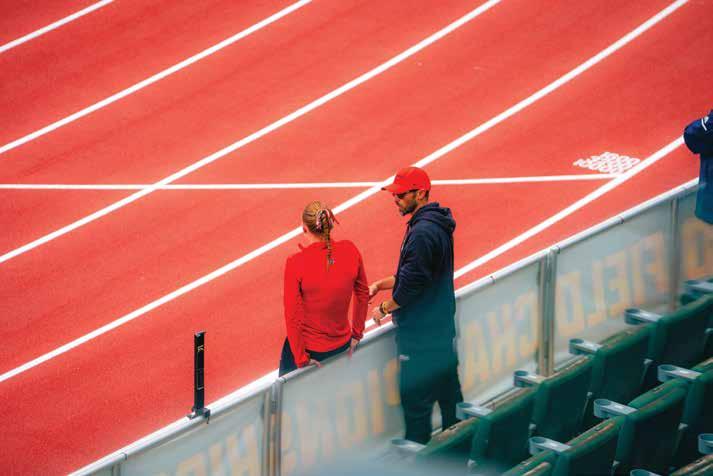
Coach Hanenberger, who oversees the sprinters and hurdlers for the SDSU Jackrabbits, was also on the same page with the return to movement protocol. “Immediate movement…walking to marching, to low level skips, to high level skips to stationary hops to horizontal bounds, to striding to acceleration (drills to dribbles to sprint),” said the coach, who was the head coach at St. Cloud State (Minnesota) prior to moving to SDSU. There were other excellent thoughts on what should happen with hamstring rehab. “Hip strength and mobility have helped the most,” said Coach Korbelik, who came to the University of Mary in 2020, and who has continued the Marauder tradition of success. “Hip alignment and making sure things are balanced. Focusing on the glutes more than the hamstring. We get a lot of overuses of the hamstring in the weight room, which results in the hamstring not being fully recovered when we run again. I have found you have to be really smart in the weight room about not overdoing it. I look at hinge exercises in the weight room as more beneficial and not just focusing on the hamstring,
but doing compound lifts that are holistic,” noted the coach. Korbelik also said that his favorite treatment modalities were dry needling, cupping, massage, stim machine and compression.
It was interesting to see the differences in how athletic trainers and some of the strength coaches approached hamstring rehab. The Minnesota Gophers trainer (Alexandra Fruetel) said Blood Flow Restriction rehabilitation (BFR) had really worked well in her program. “I have had my recurring hamstring injury athletes start using BFR two to three times a week. (BFR or Blood flow restriction is a technique that uses a specialized tourniquet system similar to a blood pressure cuff to partially restrict blood flow to an arm or leg during exercise) Long term, I feel like this gives the most benefits, helping with both muscle fatigue and recovery. BFR has been the key to keeping those injuries away. It helps with the recovery process and really has made a big difference in athletes continuing to train. Between that and treatment when needed, those are the only two things that I incorporate. For treatment, I use dry needling the most, and
dry needling with stim. With adding the stim to the needles, the muscle is getting deep stimulation to trigger point tissue that lay beneath the fascia. The other thing I have started to pay attention to is if the issue is in the muscle, or in the fascia. This makes a huge difference in what I am going to do to treat the problem.”
“An on-the-track and weight room program geared towards the demands on the tissue placed on it during sprinting, and a hamstring training continuum in the weight room that biases connective tissue and eccentric loading,” declared the Buckeye strength coach, Colton Razo, when asked about hamstring rehab.
The Houston Cougar strength coach, Jamal Jones, was even more specific. “The best approach is to combine eccentric and isometric strength training,” voiced Jones. The primary eccentric hamstring exercise we do is Nordic curls, and isometrically, we do three-position leg curls to further increase the loading capacity of the hamstring.”
Most of the coaches were on the same page

when it came to dealing with athletes who suffered from chronic hamstring problems. Coach Jefferson, who started her coaching career in 2018 at Florida, summed it up best: “Rehab is NOT OPTIONAL for those with chronic hamstring Injuries,” stated the coach very emphatically. “I demand that they are familiar with the training room and rehab BEFORE they start having issues. I have found those athletes who are proactive in prehabilitation — working on the surrounding muscles to support hamstring health — have the least amount of reoccurring hamstring issues.”
Korbelik, who started his coaching career at Whitworth University (Washington) in 2017, was on the same wavelength as Jefferson. “We monitor athletes with chronic issues very closely,” he noted. “We limit their speed and spike sessions. We keep intensity at 90%.” Coach Vega at NDSU said his protocol for athletes with chronic problems has always been “less is more.” “From my experience,” he said, “a lot of chronic hamstring issues result from a biomechanical reason. Therefore, we work a great deal on running form and technique.”
Coach Hanenberger says he approaches it much like the other coaches offered: “Typically,” said the coach, “we use less training density than the regular event group and we have more active recovery between training sessions.”
Nearly all the coaches agreed that the cause of the hamstring problem must be diagnosed and addressed, or the issue will continue to be an ongoing, chronic complication.
All the different entities (coaches, strength and conditioning coaches, and athletic trainers) stressed the importance of working together in both the prevention and rehabilitation of athletes dealing with hamstring injuries.
Most of the survey coaches echoed the same thoughts on this aspect. “We work together with a systematic and weekly training approach,” revealed Coach Radcliffe, who has worked with the Oregon Track Club Elite. “With the sports medicine staff, we work to get back systematically from the symptom.”
Coach Robinson from the Red Raiders said basically the same thing, when talking about working together in a group effort. “Yes, 100%! We have developed what
I call a ‘Training Triad,’ which includes myself, the strength and training staff, and the athletic training people. This triad is coach driven, but input from all three support systems is necessary for the athlete’s success on the track.”
Coach Korbelik stated it very simply: “It is a must to have everyone on the same page,” he declared. “Oftentimes the demands that happen on the track are not understood and it is my job to communicate this.”
Coach Jefferson had a little different take: “I work more with the athletic training staff in the prevention and rehabilitation of hamstring injuries,” she explained. “I believe that athletic trainers have more first-hand knowledge on what is necessary for athletes to be able to run at higher intensities as it relates to track and field specifically.”
Fruetel had an excellent athletic training perspective. “I would say we collaborate the best we can. I communicate when I think there may be a higher chance of injury when someone feels multiple days of fatigue/soreness, and the coaches are able to do what they would like with that information. It also depends on what point we are at in the season as well. During the fall, we know that we need to build so I am more likely to push limits within safe measures, but during season we tend to error on the side of caution. We mostly collaborate on what the athlete is feeling, and then coaches have that information to make adjustments.”
I entered this project very idealistic, thinking someone would have a nice, simple solution to the hamstring dilemma. I was hoping that it was just me that couldn’t solve the hamstring problem for my athletes after nearly 50 years of coaching.
That wasn’t the case. The article and our research showed there is no magical fix or solution. It reinforced what many coaches have found. It is a very misunderstood injury, as Coach Schexnayder says, that can be very frustrating and often reoccurs.
One theme from our project that really stood out: It is exceedingly difficult to provide the proper rehab for an athlete with a hamstring injury without knowing the cause of the injury. And that is not always an easy task, with the myriad number of causes and typically a combination of things that can contribute to the injury.
An important talking point that resulted from this article: The hamstring injury
quandary is a complex issue that will require excellent communication and “teamwork” between coaches, strength and conditioning coaches, and athletic trainers if there is to be success in both the prevention and rehabilitation of the injury.
The legendary Jackie Joyner Kersee, the three-time Olympic gold medalist, and still the world record holder in the heptathlon, sums up our thoughts exactly concerning this article with this quote: “It is better to look ahead and prepare than to look back and regret,” said the former UCLA track and field/basketball star who competed in four different Olympic Games. In other words, doing the necessary prevention measures will result in a lot less hamstring injuries. And hopefully, a lot less headaches and regrets.
Although we didn’t arrive at a solution or “fix” to the hamstring injury dilemma, we did offer some critical insight and understanding into the hamstring’s role in sprinting, some of the major causes of hamstring woes, and a great deal of prevention and rehabilitation tactics. Our hope is that this information will better prepare coaches to deal successfully with their athletes in terms of prevention and rehab if they do encounter hamstring difficulties.
McMillian, Stu, Altis articles, clinics
Schexnayder, Boo, clinics, articles, “A Guide to Handling Hamstring Injuries for the Coach”
***A very special thanks to Ann Thorson and Amelia Sherman for editing and technical assistance

You not only get the best out of them, you want the best for them. For some of your student-athletes, that could mean introducing them to a cause worth fighting for in the United States Marine Corps. We’d like to talk to you about what it takes to be a Marine, so you can be the knowledgeable resource your student-athletes need and deserve.


AN OVERVIEW OF FATIGUE, RECOVERY, AND REGENERATION
• Fatigue Basics. Physical fatigue can be defined as a state of disturbed homeostasis attributable to work and to the work environment. Fatigue is a very common and important constraint in physical activity. The physical limitations due to fatigue are multi-factored, individualized responses in humans. Research has shown fatigue to be a very complex conception, involving both psychological and a host of physiological factors. This can give rise to subjective, as well as objective symptoms, but so far very little is known about the nature of this disturbed homeostasis. The subjective symptoms of fatigue range from a slight feeling of tiredness to complete exhaustion.
• Physical Fatigue. Physical fatigue can be defined as a state of disturbed homeostasis in the physiological processes and physical structures of the body (excluding psychological factors).
• Identifying Causes of Fatigue. In the training of endurance runners, coaches must recognize all of the stimuli sources that cause fatigue in athletes. It is only then that proper recovery can be prescribed, and regeneration can occur in the human body.
• The Recovery Period. The resulting rebound time period from a fatiguing training stimulus is termed the recovery period. This is a period of time when the bodies’ cells, tissues, and organs proceed through a systematic regenerative process.
• Supercompensation. The specific physiological area of fatigue should recover to a performance level superior to the physical state preceding the fatiguing stimulus.
• Local and General Fatigue. Exercise can cause fatigue locally and globally, distinguishing between the two is an important part of coaching practice.
• Fatigue by Accumulation. Fatigue can result from the performance limiting accumulation of cellular by-products. For example, hydrogen ion accumulation in the muscle and blood may produce fatigue.
• Fatigue by Depletion. Fatigue can result from the depletion of energetic substrates. For example, the depletion of carbohydrates and free fatty acids in the muscle can produce fatigue.
• Fatigue by Altered Metabolic Function. Fatigue can result from changes in metabolic functions due to acidity changes or disturbances in body core temperature. For example, acidity related disturbances in the actin-myosin function and calcium pump can produce fatigue.
• Neuromuscular Junction Limitations. A limitation at the neuromuscular junction can cause fatigue. For example, an inefficient sodium-potassium pump can result in symptoms of fatigue.
REGENERATION
• Positive Regeneration. The negative influences on performance caused by fatigue are counteracted during every training load by positive influences achieved during regeneration. Negative influences should be countered by equal and opposite regeneration processes.
• Exogenic Factors in Regeneration
• After Long Durations of Exercise
• Post-Exercise Stretching
• Adequate Fluid Intake
• Proper Nutrition
• Abundance of Sleep
• After Intense Exercise of Short Duration
• Mild Aerobic Exercise
• Acidity Recovery. These exercises assist in regenerating returning metabolic levels to normal after periods of high acidity.
• Training Load Establishment
• Establishing and Increasing Training Loads. The establishment of a sufficient level of training load tolerance through a wellplanned program is critical. The most important factor in improved endurance running performance is the development of tolerance to increasing training loads during the training year
• Avoiding Premature Loading. Avoid premature loading in training design and administration. The following practices will assist in this goal.
• Restoration Phases. Do not add another load in the restoration phase.
• Allow Time to Recovery Before Reloading. If loading is premature, and the athlete has not recovered to the previous homeostasis level, then not only will recovery be compromised, but the new load may not bring about the planned adaptation. There is no value in loading an athlete before restoration has been complete.
• Appropriate Loads and Supercompensation. If over-compensation is to be successful, then a positive performance adaptation will occur with the physiological adaptation, thus causing the athlete to reach a higher level of homeostasis. If the load is too extreme it may be impossible for physiological adaptations to occur in the time frame allowed for compensation and over-compensation. Extreme fatigue, with a high level of disintegration of cell functions, causes reversible damage in certain structures that need time to repair.
• Other Load Related Damage. Other structural losses with an extreme load in endurance training include a reduced synthesis of albumen by 50%, micro-traumas in cell structure, changes in the plasma membrane, and mitochondria swellings.
• Negative Influences on Regeneration
• Unfavorable Environmental Circumstances
• Insufficient Nutrition and Fluid Intake
• Lack of Sleep
• Illness
• Positive Influences on Regeneration
• An Optimally Organized Loading Structure
• Rapid Replenishment (Carbohydrates, Water, Electrolytes)
• Relaxation
• Physiotherapy
GENERAL INTERVAL TRAINING RECOVERY GUIDELINES
• Gerschler-Reindel Law. Gerschler determined that that during the first one-third of rest interval required for full recovery, twothirds of the recovery takes place. This is the guideline coaches use today in setting up appropriate rest intervals, depending on the desired physiological adaptations, in concert with the training concepts listed.
• Aerobic Training Recovery Guidelines
• Recovery Times. The interval between each aerobic stimulus is normally between 1 and 2 times the running time of each repetition.
• Recovery Strategies
• Complete Recovery. A return to near preexercise heart rate or homeostasis.
• Incomplete Recovery. Work commences after one third of the time required for full recovery (HR of 120-130 bpm).
• Recovery Techniques. Recovery techniques are the methods used to aid in recovery between repetitions. These might include jogging, walking, standing, dynamic flexibility exercises, etc.
• Anaerobic Training Recovery Guidelines
• Work Intensities. Intensity for anaerobic work exceeds 90% of maximum velocity.
• Recovery Intervals. Recovery requires more time between both repetitions and sets than that used in aerobic training. Rests must be significant to ensure high quality and preserve power output throughout the session. Rest intervals might range from 3-4 minutes in speed development work to 15-20 minutes in special endurance work.
REGENERATION BETWEEN WORKOUTS AND RACES
• Regeneration After Anaerobic Training. Anaerobic training results in extensive muscle tissue damage and central nervous system fatigue. Recovery time requirements following anaerobic work are normally 36-48 hours before attempting this type of work again.
• Regeneration After Aerobic Training. Extensive muscle glycogen depletion and muscle tissue damage following high volumes of aerobic training. Intense and extensive aerobic work requires recovery times of 48-72 hours, while less intense aerobic sessions require 24-48 hours
• Regeneration After Racing. Extensive muscle damage, serious glycogen depletion, and increased cortisol levels result from racing. Required recovery times range from 24 hours to several days depending on the event or events. Racing and hard training have a depressing effect on the immune system, which may last several days.
REGENERATIVE TECHNIQUES
• Nutrition
• Glucose Polymer Drinks. Glucose polymer drinks should be taken immediately following exercise. Recovery is linked closely to the replenishment of carbohydrates. To maximize the rate of recovery, have athletes consume 0.6 gram of simple carbohydrate per pound of body weight within 30 minutes after the running session and every two hours for four to six hours.
• Post Training Meal. A simple and complex carbohydrate meal closely following a moderate aerobic session has been shown to aid in repletion of muscle and liver glycogen. Replenishment measurements show 60% in first 10 hours and 95% replenishment in 24 hours.
• Diet. In addition, a normal diet is sufficient after anaerobic or long aerobic interval/ repetition sessions. Replenishment measurements show 39% replenishment within 2 hours and 53% within 5 hours. The body needs 24 hours to reach an 80% replenishment level.
• Nutrition Patterns
• Good Food Choices
• Inclusion of Red Meat
• Inclusion of Complex Carbohydrates
• Inclusion of Fruits and Vegetables
• Inclusion of Whole Grains and Cereal These should have a favorable sodium to potassium ratio.
• Variety. Variety in food choices ensures proper intake of trace nutrients.
• Assuring Proper Volumes of Food Consumption
• Portion Control
• Correct Timing of Meals
• Using 4 to 5 Meals Daily
• Using Proper Prior Planning. Good habits can be developed by using shopping lists,
containers, and considering food preparations.
• Meals. The meal plan should account for breakfast, mid-morning, lunch, carbohydrate replacements, dinner and bedtime snacks
• Snacks. Snack on a variety of commercially available energy bar products.
• Hydration. Proper hydration is required to restore blood volume, as well as electrolytes lost during exercise.
• Proper Hydration Practices
• Use of Water Bottles
• Locker Room Availability
• Carrying Water During Travel
• Water Intake Guidelines
• Intermittent Drinking, Particularly Post Training
• Small but Frequent Amounts
• Electrolyte and Glucose Replacements
• Replacement Drinks Needed
• Water, 8 ounces of 6% glucose solution should be consumed within 20 minutes of a stressful run, and followed by 8 more ounces within 2 hours.
• Sleep
• Sleep Patterns
• 7.5 to 8.5 Hours of Sleep per Night
• Regular Bedtime. Go to bed at the same time every night.
• Regular Time to Awaken. Get up at the same time each morning
• Methods for Achieving Optimal Sleep
• Use Custom Molded Ear Plugs
• Do Not Disturb Sign
• Cooperation with Roommates/Family
• Natural Sleeping Aids. Any aids used should be all natural, such as melatonin, tryptophan, or complex carbohydrates.
• Sleep Rituals. The use of music, meditation, relaxation techniques assist in sleep.
• Avoid Drinking. Avoid drinking within 20 minutes of bedtime.
• Avoid the Phone. Avoid using the telephone within 20 minutes of bedtime.
• Massage. Massage aids in recovery through increased circulation to damaged tissue. Massage also decreases muscle tension and fatigue.
• Cryotherapy. Cryotherapy Reduces inflammation to damaged tissue.












































































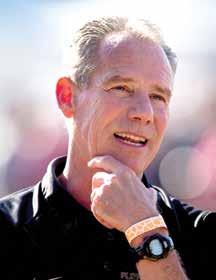
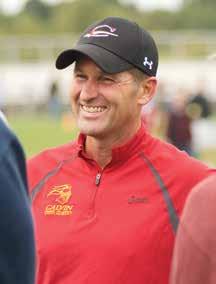

BOB BRAMAN
Before Bob Braman “unretired” in May, his coaching achievements had already reached Hall of Fame worthiness – leading Florida State to twice earn the John McDonnell NCAA Division I Men’s Program of the Year award (2010-11 and 2011-12) while also having two Seminoles receive The Bowerman (Ngoni Makusha 2011, Trey Cunningham 2022). Under his leadership, FSU twice won NCAA DI outdoor team titles (2006, 2008) and finished on the podium 13 times combining men and women, indoors and outdoors. Three of his athletes were named USTFCCCA National Scholar Athlete of the Year and two of his squads were named USTFCCCA National Scholar Team of the Year.
BRIAN DIEMER
Calvin
In the midst of being a 3-time Olympic steeplechaser – topped by a bronze medal – Brian Diemer began coaching at Calvin University for what he thought would be two years. His tenure ended up lasting 36 years, forging dominance in the Michigan Intercollegiate Athletic Association –43 total team titles in cross country, including 34 in a row on the men’s side from 1987-2001. His men’s teams also were NCAA Division III national champions four times (plus runnersup three times) while his women’s squads were on the podium three times. On the track he coached two different athletes to national back-toback titles in the steeplechase – a first in DIII history.
Michigan
James Henry’s championship success at Michigan as an athlete came nowhere what he would do as a Wolverine coach. He won the 1980 Big Ten outdoor long jump title, spearheading the Maize and Blue to the team title. Less than four years later he became the first-ever black head coach of a varsity sport at Michigan. Henry led the Wolverines to is first women’s Big Ten triple crowns (1993-94, 1997-98) and women’s NCAA DI track & field podium appearances (third in 2007 outdoors & 2008 indoors). His athletes accumulated 193 All-American awards and he was named Big Ten Coach of the Year 12 times.

Pittsburg State
An All-America decathlete at Pittsburg State, Russ Jewett accumulated four head coaching titles for his alma mater as the Gorillas ventured from the NAIA to NCAA Division II in the fall of 1989. Over the next 32 years, Jewett’s teams captured 50 Mid-America Intercollegiate Athletics Association team titles – 37 in track & field, 13 in cross country – and two NCAA DII team titles in (2016 women’s outdoor) and (2018 men’s indoor). When he retired from coaching in 2021, his athletes had won 34 NCAA event titles, and he was named Coach of the Year three times nationally, plus 17 regionally and a record 44 in the MIAA.

LSU
Irving Schexnayder is not the name that countless athletes and fellow coaches know him as – for most, it’s simply his nickname of “Boo.” By any name, his brilliance shined as both a coach and an educator of other coaches. His success as a coach included guiding athletes to 26 NCAA event titles during a career primarily at LSU, where he was named National Assistant Coach of the Year in 2004. He was also instrumental in founding the Track & Field Academy – the educational branch of the U.S. Track & Field and Cross Country Coaches Association, for which he served as program director from its inception in 2009 to 2017.

Missouri Southern
Patty Vavra blazed a trail both to and at Missouri Southern. In 1976, she was the school’s first female to receive an athletic scholarship and excelled in basketball and track & field. She returned to MSSU in 1994 as the Lions’ head coach in women’s cross country and track & field, winning a total of 14 Mid-America Intercollegiate Athletics Association team titles that included a Triple Crown in 2007-08. Her athletes earned 90 All-America honors – 80 in track & field – and her cross country squads won three consecutive regional titles. She held several leadership roles within the USTFCCCA and in 2014 received the Association’s Jimmy Carnes Distinguished Service Award.

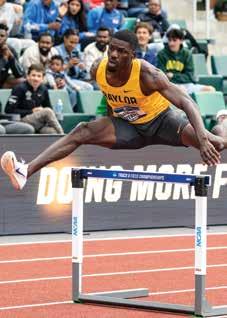

JORDAN ANTHONY
Arkansas
Anthony, who hails from Tylertown, Mississippi, earned the title of “Fastest Man in Collegiate Track & Field” after completing the 60-meter/100-meter double at the NCAA Championships in 2025. The Arkansas standout won the 60 meters back in March and then stormed to victory in the 100 meters at the NCAA Outdoor Championships in Eugene, Oregon. Just a few weeks before winning his second NCAA title of the year, Anthony scorched a barely wind-aided 9.75 (+2.1) to equal the second fastest all-conditions performance in collegiate history and equal to the ninth fastest all-conditions performer in world history. He also finished fourth in the 200 meters and anchored the third place 4×100 relay in Eugene. Anthony is the third male athlete from Arkansas to be a finalist for The Bowerman, joining 2016 winner Jarrion Lawson and 2022 finalist Ayden Owens-Delerme.
NATHANIEL EZEKIEL
Baylor
Ezekiel, who hails from Delta State, Nigeria, capped a prolific season in the 400-meter hurdles with an NCAA title in TrackTown USA. The Baylor standout went a blistering 47.49 – just two days after lowering his PR to 47.86 – to take his rightful place atop the podium and move up to No. 3 in collegiate history behind two other past finalists for The Bowerman: Rai Benjamin (2018) and Caleb Dean (2024). Ezekiel ended the season as the only man in collegiate history with multiple alltime top-ten marks in the event. Multiple means two or more: Ezekiel has four. During the indoor season, Ezekiel clocked the seventh fastest mark in collegiate history in the 400 meters and finished a close runner-up in that event at the NCAA DI Championships – by close, we mean 0.01 seconds. This is the first time in program history that an athlete from Baylor has been named a finalist for The Bowerman.
Tharp, who hails from Murfreesboro, Tennessee, ended his outdoor season the same way he did the indoor season – winning an NCAA title and becoming the fifth fastest performer in collegiate history in that event. The Auburn standout most recently hurdled his way to an NCAA title in the 110-meter hurdles in PR 13.05. That came several months after he went PR 7.45 for the indoor 60-meter version. Tharp went 13.15 or faster four times during the outdoor season and avenged his only two losses of the outdoor season with that victory at the NCAA Outdoor Championships. Tharp is the first athlete from Auburn to be named a finalist for The Bowerman. Fan voting for The Bowerman begins today on The Bowerman’s website and runs through Thursday, July 10. Paper voting also begins on Tuesday, July 8 and closes in late July.
Anthony, Ezekiel, and Tharp will be feted on Thursday, December 18, during the annual USTFCCCA Convention, which will be held at the Gaylord Texan Resort & Convention Center in Grapevine, Texas. One of those three incredible athletes will take home collegiate track & field’s highest individual honor that same night following The Bowerman Presentation.

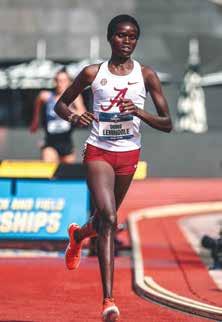
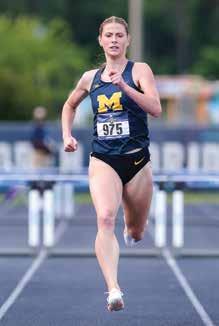
New Mexico
Kosgei, who hails from Elgeyo-Marakwet County, Kenya, capped an undefeated collegiate outdoor season with titles in the 5000 and 10,000 at the NCAA DI Outdoor Championships. The 10k victory came first in meet-record time with the No. 3 all-time collegiate performance time of 31:17.82 (she has No. 2 at 31:02.73). In the 5000 she moved to No. 2 all-time collegiately in winning April’s Bryan Clay Invitational in 14:52.45, missing the CR by just 0.27 seconds. In between her 10k and 5k PRs she won the steeple at the Stanford Invitational in 9:15.93, then No. 2 and now No. 3 all-time collegiately. She had another impressive 10,000 performance, winning the Don Kirby Tailwind Twilight by over five minutes in 31:58.51 – at 5120 feet (1560 meters) of altitude in Albuquerque, New Mexico, in registering the fastest time for any woman at high altitude outside of Africa. Indoors she was third in the NCAA DI 5000 before taking 11th in the 3000. Kosgei is the first New Mexico athlete to be a finalist for The Bowerman.
Alabama
Lemngole, who hails from West Pokot County, Kenya, lowered her own CR in the steeple twice in 2025, ultimately to 8:58.15 to become the first collegiate sub-nine steepler and crack the alltime top-ten in world history. The first time Lemngole bettered the standard with her 9:10.13 effort back in April. Her domination of the event can be shown at least a couple of ways – one with five top-11 all-time performances, including the last three CRs, and another with winning margins in the steeple this year ranging from 10.53 to 40.77 seconds. Indoors she had a pair of notable 5000-meter races – the first in a CR 14:52.57 in early December and the other in mid-March to win the NCAA DI Indoor title in 15:05.93, the No. 9 alltime performance collegiately. She was also runner-up in the 3000 at the NCAA DI Indoor after earlier moving to No. 5 on the all-time collegiate list at 8:41.83. Lemngole is the first Alabama athlete to be a finalist for The Bowerman.
SAVANNAH SUTHERLAND Michigan
Sutherland, who hails from Borden, Saskatchewan, broke the CR in the 400 hurdles while winning the NCAA DI Outdoor title in 52.46, slicing 0.31 seconds off the 52.75 set in 2018 by Sydney McLaughlin. That also made her the ninth fastest woman in world history. Sutherland had another sterling race in mid-April, winning the Tom Jones Memorial Invitational in 53.46 – the No. 8 collegiate performance all-time in the first-ever race with three collegiate sub54 times. Undefeated at all distances outdoors, she recorded a 49.99 second-leg split on Michigan’s program record-setting 4×400 team, which ran 3:29.22 at the NCAA East First Round (after she earlier set a meet record of 54.39 in the 400 hurdles). Indoors the closest race to her specialty was the 400 and she clocked her fastest ever in the event – indoors or outdoors – in placing fourth at the NCAA DI Indoor Championships (her only loss in any individual event all year). Sutherland is the first Michigan athlete to be a finalist for The Bowerman.




